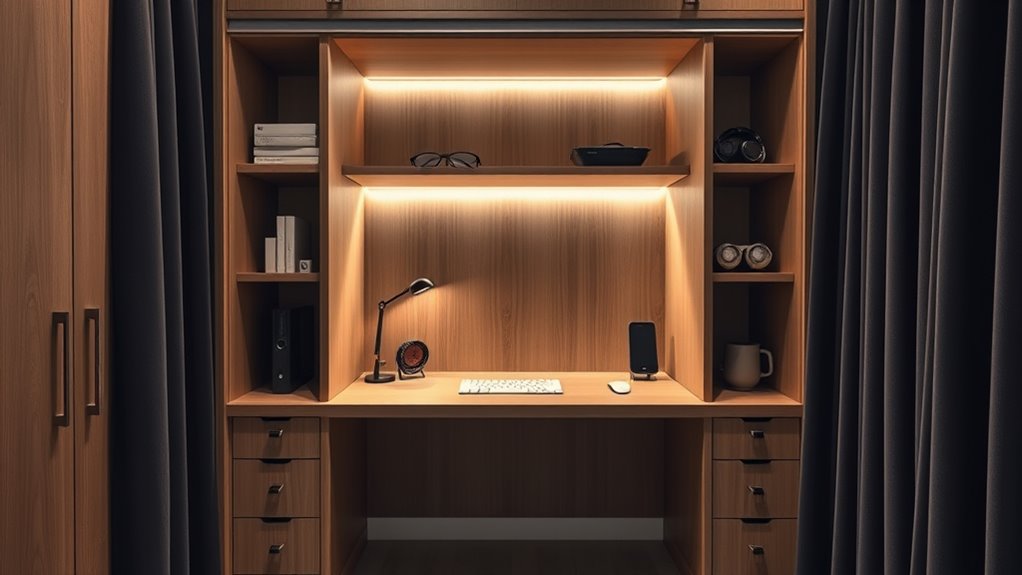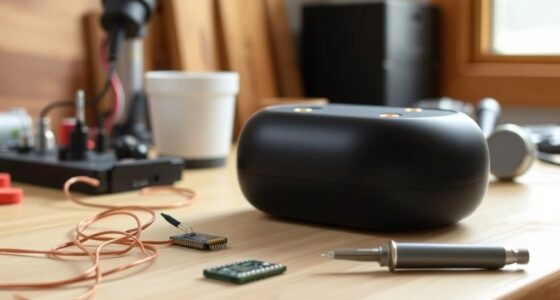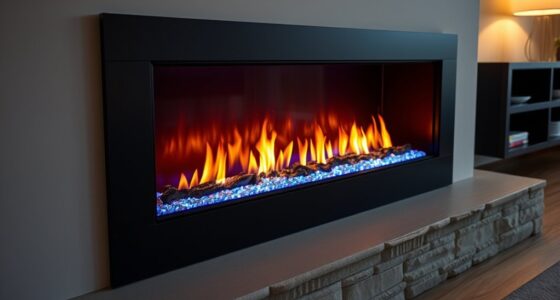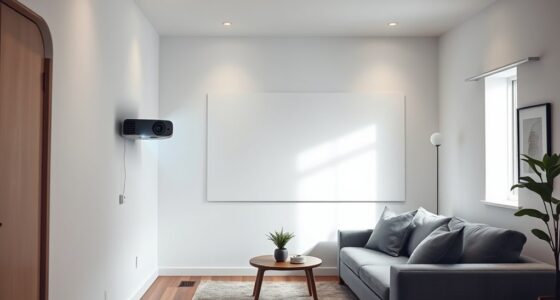To build a hidden desktop in a closet, install a compact, well-ventilated setup with wireless peripherals to reduce clutter. Use a power strip inside the closet for centralized connections, and hide it behind panels for a clean look. guarantee proper ventilation or small fans to prevent overheating. Organize cables with conduits and consider remote management to control your PC remotely. Keep exploring to discover all the tips for creating a discreet, fully functional workspace inside your closet.
Key Takeaways
- Design a discreet enclosure inside the closet with proper ventilation and insulation.
- Use wireless peripherals and remote management systems to reduce cable clutter.
- Install a centralized power strip with surge protection, hidden behind panels for a tidy look.
- Incorporate cable organizers and conduits to route wiring neatly and prevent damage.
- Ensure adequate ventilation or cooling fans to manage heat and maintain safe operating temperatures.

If you want a workspace that’s out of sight but still functional, building a hidden desktop inside a closet is an excellent solution. This setup allows you to keep your work area discreet while maintaining full productivity. To maximize efficiency, focus on integrating wireless peripherals. Using wireless keyboards, mice, and other devices eliminates clutter caused by cords and makes it easier to organize your workspace. Wireless peripherals also give you the flexibility to position your equipment wherever it’s most comfortable, which is especially helpful in a confined closet space. With no wires tripping you up or tangling, you can work smoothly without interruptions.
Power management becomes a crucial consideration when designing your hidden desktop. Since your closet isn’t a typical office setup, you’ll need a reliable way to supply power without creating mess or hazards. Installing a power strip inside the closet can centralize all your connections, but make sure it’s rated for the wattage your equipment demands. To prevent issues like overheating or accidental disconnections, choose a surge protector with sufficient outlets and built-in safety features. Consider hiding the power strip behind a false wall panel or inside a custom cabinet to keep things tidy. When planning power management, also think about cable routing—using cable organizers or conduits helps keep cords neat and prevents accidental disconnections or damage.
In addition, to guarantee your hidden workspace remains functional and safe, you might want to install a small vent or fan. Proper ventilation prevents heat buildup from your computer and peripherals, especially if the closet is tightly sealed. This helps extend the lifespan of your equipment and maintains a comfortable environment for working. Remember that wireless peripherals can reduce the number of cables running through your setup, but your main computer and power supply still need proper handling to keep everything running smoothly.
Lastly, consider integrating a remote management system for your PC. Remote access allows you to turn on or wake up your desktop without opening the closet door, saving you time and effort. It also helps monitor system health and troubleshoot issues remotely, which can be a huge advantage in a hidden setup. Combining wireless peripherals with effective power management creates a seamless, clutter-free workspace that’s hidden yet highly functional. With a little planning, you can turn a closet into a professional-grade office that stays out of sight but stays fully operational whenever you need it.
Frequently Asked Questions
What Security Measures Protect the Hidden Desktop From Intruders?
You protect your hidden desktop using strong encryption protocols to secure data and prevent unauthorized access. Implement strict access controls, such as biometric authentication or complex passwords, to guarantee only you can reach it. Regularly update software and monitor activity logs for suspicious behavior. These measures create multiple layers of security, making it difficult for intruders to breach your hidden desktop and keep your information safe.
Can the Hidden Desktop Be Accessed Remotely?
Yes, you can access your hidden desktop remotely. Imagine opening a secret portal through a secure tunnel, where VPN security acts as your trusty guard, ensuring only you can walk through. By setting up remote access tools and encrypting your connection, you keep your hidden workspace safe from prying eyes. With these measures, your hidden desktop remains accessible yet protected, giving you peace of mind wherever you are.
What Are the Power Requirements for the Concealed Setup?
Your concealed setup requires careful planning of power consumption and electrical wiring. You’ll need a reliable power source that can handle your desktop’s typical draw, usually around 150-300 watts, depending on your components. Make certain the wiring is discreet and safely installed to prevent shorts or fire hazards. Use a surge protector or UPS for protection. Confirm that your power setup complies with local electrical codes for safety and efficiency.
How to Ensure Proper Ventilation and Cooling?
You should investigate whether proper ventilation strategies improve cooling efficiency. To guarantee your setup stays cool, install a small exhaust fan or a vent system to promote airflow. Use cooling solutions like desk fans or air conditioning units if needed. Regularly check for dust buildup and keep vents clear. Proper ventilation and cooling solutions keep your hidden desktop running smoothly and prevent overheating, ensuring long-term performance.
Is Professional Installation Recommended for Complex Setups?
Yes, professional installation is recommended for complex setups, especially if you want a reliable, safe, and efficient system. While a DIY setup might save you money initially, complex builds often require specialized skills and tools that guarantee proper wiring, ventilation, and stability. Considering your budget, investing in expert help can prevent costly mistakes, prolong your system’s lifespan, and ensure your hidden desktop functions perfectly without issues.
Conclusion
So, after all that effort to hide your desktop behind a closet door, you’ve created the perfect secret lair—only to realize it’s now just a dusty, forgotten corner. Luckily, your covert workspace is so well concealed, no one will ever find your embarrassing browsing history or those late-night gaming sessions. Ironically, in hiding your tech, you’ve turned a simple computer into a mysterious, almost legendary relic—proof that sometimes, the best secrets are best kept hidden.









